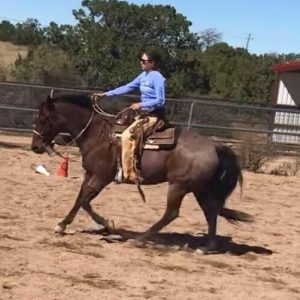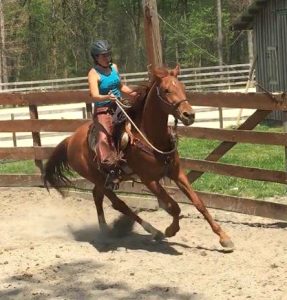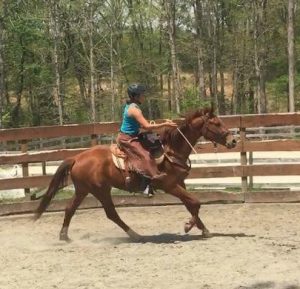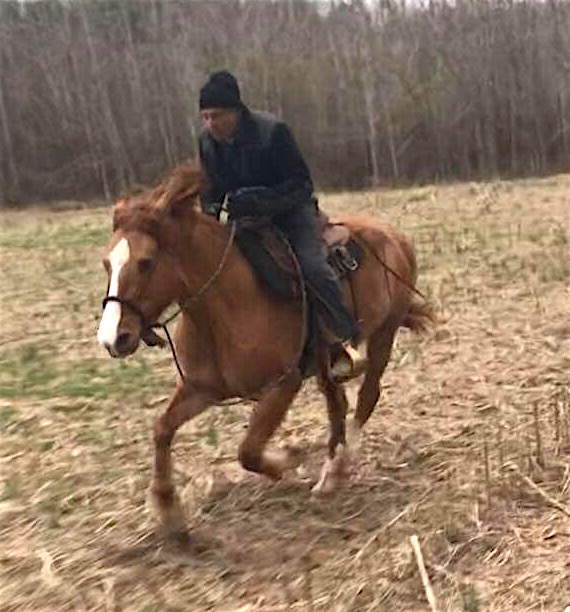 Editor’s Note: Amy Skinner is a regular guest columnist and has been a horse gal since age six. She will present with fellow trainer and rider, Katrin Silva, at the Best Horse Practices Summit.
Editor’s Note: Amy Skinner is a regular guest columnist and has been a horse gal since age six. She will present with fellow trainer and rider, Katrin Silva, at the Best Horse Practices Summit.
Skinner rides and teaches dressage and Western. Skinner has studied at the Royal Andalusian School of Equestrian Art in Spain, with Buck Brannaman, Leslie Desmond, Brent Graef, and many others. Visit Amy’s website here.
Skinner writes:
“Unfortunately for him we usually blame the horse, and generally wrongly. In all probability he has responded to the aids actually applied and not to the aids we think we have applied. The fault is nearly always with the rider, who, not knowing how to speak the language of the aids correctly, has failed to make himself understood, or has even expressed the exact opposite of what he wished to say.”
– Etienne Beudant, French horseman and military officer who lived from 1863-1949
When I teach, I often hear a complaint from riders that their horse is not willing to go forward. They’re frustrated and often feel that they are working harder than their horse. Forward movement is the first pillar to accomplishing anything with a horse under saddle, so if you can’t get your horse to move out, you may find difficulty and frustration in trying to accomplish much else.
 So why won’t your horse go forward, and what can be done about it?
So why won’t your horse go forward, and what can be done about it?
Let’s explore some of the reasons a horse might not be so willing or able to move freely:
Are you actually afraid to go forward?
Many riders aren’t comfortable going forward in the true sense of the word. Fear prevents them from going above a trot and impacts their implementation of cues for forward movement. As a result, their horses become sticky about going forward.
The cruel truth is if you can’t control your horse at faster gaits, you can’t truly control your horse at the slower ones. It’s important to be able to practice all gaits. Often I see riders beg their horses to go, but then “snatch” the reins and slow the horse back from the faster, requested gait. If you’re afraid of going forward, your horse cannot commit to being truly free in its movement.
 Are you loose in your seat and following with your hands?
Are you loose in your seat and following with your hands?
Many riders grip with their knees or ankles. They restrain or fail to follow their horses’ head with their contact. Even on a loose rein, a hand that doesn’t follow restricts a horse’s movement.
Learn to develop a following and loose seat. A loose and effective lower leg starts with a loose hip and lower back, so if these are areas of tightness for you, find an instructor and/or physical therapist/fitness coach to help you with this.
How do you give a leg aid? Do you nag? Is your leg effective?
If your heel comes up and you grind your leg without release, your horse will find this offensive and will eventually learn to ignore it. This posture also closes your hip angle. Imagine sitting on a garden hose. Your goal is to allow the water flow under you and out the front of the hose. Closing off your hip angle and pinching with your knee doesn’t allow the water to come forward. The posture also raises your center of gravity and forces the horse to have to rebalance you, all taking extra effort on his part.
 Horses that don’t go forward often get conflicting signals. You may be grinding with your leg while pulling back with your hand.
Horses that don’t go forward often get conflicting signals. You may be grinding with your leg while pulling back with your hand.
Horses that don’t go forward are often stiff and crooked. If the horse is not straight and supple, a lot of energy is being wasted in directions other than forward. Again, think of the garden hose, except this time it’s riddled with holes. Lots of water leaks out left and right, and this causes the stream out the end of the hose to be weak. Think of straightening the hose by plugging the holes. Now you can allow the water to come forward out the end.
Do you practice the faster gaits?
It’s easy to complain that your horse won’t go forward, but if you only walk or trot at a sluggish pace, the horse knows of no speed range. It’s especially problematic if you nag with your leg frequently at these gaits. The horse may just believe this is riding life – sluggish movement with a lot of noise from a rider.
Practice walking slow, walking fast, trotting slow, trotting fast, cantering, and yes, galloping. If you want a horse that is able to go forward, you must get comfortable riding forward yourself. In order to be safe, horses need to be ridden through the range of gaits and controllable at each one. If you avoid the faster gaits, what happens when you’re suddenly in one without meaning to? Your horse will have no practice there and doesn’t know what to do, and neither will you.
 Make sure your riding is varied. It’s normal and completely understandable for a horse to lack enthusiasm about going forward if you aren’t actually doing anything. Riding circles around the arena or plodding endlessly down the trail aren’t necessarily thrilling activities to a horse. Make your arena work dynamic and engaging. Make your trail rides the same – engage your horse’s mind by directing them around different natural obstacles, change their posture up and down hills, ask them to think and respond. If your mind is shut off, theirs can be too.
Make sure your riding is varied. It’s normal and completely understandable for a horse to lack enthusiasm about going forward if you aren’t actually doing anything. Riding circles around the arena or plodding endlessly down the trail aren’t necessarily thrilling activities to a horse. Make your arena work dynamic and engaging. Make your trail rides the same – engage your horse’s mind by directing them around different natural obstacles, change their posture up and down hills, ask them to think and respond. If your mind is shut off, theirs can be too.
Riding a horse that is truly forward is a pleasure. This horse is loose in its body, willing and able to ride in any gait without loss of control, and has a confident, quiet mind. Practicing going forward is essential to the mental health of a horse, and if you can get comfortable with the idea of it, it’s liberating.
Great article! I found that my horse broke gait a lot because she wasn’t straight, and I didn’t understand what straight meant until I found a great instructor who emphasized it. As soon as I was able to feel straightness, things clicked into place. Impulsion, rhythm, connection – all those things were possible for us when we became straighter and therefore stronger in mind and body.
Thanks for that. IMHO the gallop is very under rated and many folks are scared of it. Horses have a genuine need to really stretch out once in a while, and they usually won’t go for very long. It’s fun and exhilarating but takes effort! And when I say stretch out, I mean actual, physical stretching. An unbalanced horse will use speed for balance and if one never lets them find themselves, it’s a catch 22 for the horse. In the beginning of her rehab, I had to find safe places to let my mare out, on a very loose rein. It was an act of faith, and she didn’t let me down.